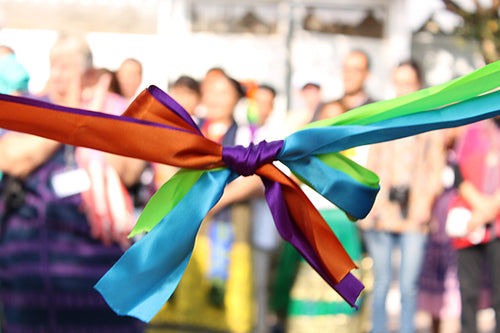
Florentina López de Jesús (1939 — 2014), Xochistlahuaca, Guerrero
Known as Tina, Florentina López de Jesús sat as a child by her mother's side watching her weave. It looked like play to Tina, her mother's hands moving over the threads on her back-strap loom, magically combining the elements until she produced a symphony of cotton and color. Her love of weaving, born at her mother's side, has led her to research the colors found in the countryside of her native Guerrero in order to create natural dyes that give life to the white cotton. She has never been married and has no children.
Born in 1939, Florentina belongs to an ethnic group known as the Amuzgo. She has carved out a social role for herself as both promoter and teacher of textile techniques, conducting classes throughout the region near her native Xochistlahuaca, Guerrero.
She belongs to the cooperative La Flor de Xochistlahuaca dedicated to preserving the knowledge and practice of weaving on a backstrap loom and the natural cotton they use which grows in white, green and a brown color called coyuche (Coyuche has been cultivated, spun and woven for as long as anyone can remember). The coop maintains quality in all their processes of spinning and weaving and teach new generations their art.
Until 1980 when she began receiving awards for her work, Tina sold only to other women in the village or by special order. Winning first place in two competitions, the "Por siempre el rebozos" (1991) and "Las manos de México" (1994) have continued gaining recognition for this master craftswoman.
A tireless woman, Tina also tends to her housework and helps with field-work, the focus of which is the planting, cultivation and harvesting of cotton, both the white and a type known as coyuche. This latter variety yields fibers of a light brown tone and is quite difficult to cultivate, a feat worthy of recognition with regard to this couple.
Tina also does her own spinning and dyeing before she begins weaving on her back-strap loom, an implement which she operates with mastery. She works with a cooperative, "Flor de Xochistlahuaca", where the women of her village unite in order to bring more money into their households.
This simple loom is of pre-Hispanic origin. It is composed of two thick bars to which the warp is attached, one or more heddles which separate the threads, and a bar with which to open the warp so as to insert, with the aid of shuttles, the weft threads. Tina has mastered various weaving techniques but her specialty is the production of gauze brocade. The brocade is a decorative element that is woven at the same time that the fabric is created. Extra threads are inserted, with the shuttles, along with the weft threads, resulting in designs of extraordinary quality that form part of the weave.
Among her creations is the traditional huipil, composed of three panels joined together by strips of fabric or bands of lace work called randas which add a further decorative element to the garments. The panels are folded over and sewn along the edges to create a type of tunic. Openings are left for the arms and a cut is made in the central panel for the head.
Cooperativa La Flor de Xochistlahuaca S.C de R.L.
Calle Vicente Guerrero No. 44,
Xochistlahuaca, Guerrero
741 415 2182 (cooperative) or 741 107 9634 (Yecenia López)
tsjoomsuljaa@hotmail.com (Yecenia López)

